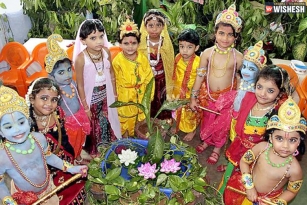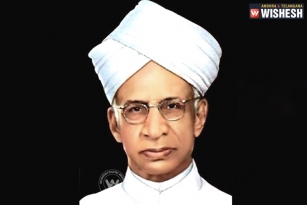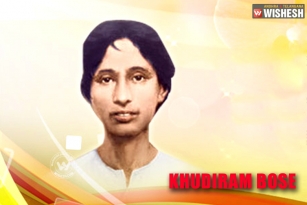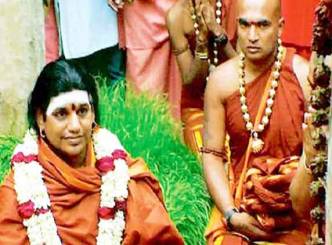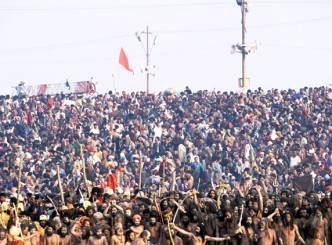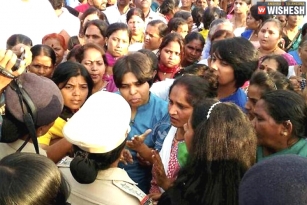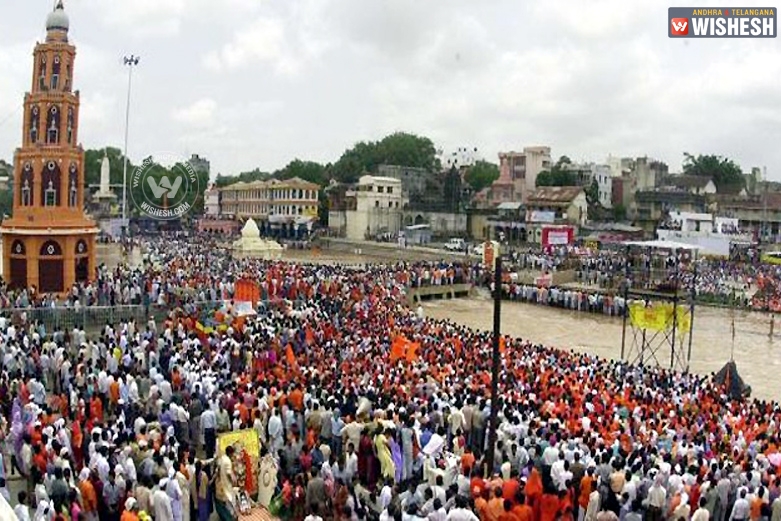
Simhastha (Nashik) Kumbh Mela is the largest congregation of faith in the world, began today the 14th July 2015, with the traditional ceremony of hoisting of flags and thousands of people taking a holy dip in Kushawart and Ramkund in Godavari river in the two towns of Trimbakeshwar and Nashik. Union Home Minister Rajnath Singh and state Women and Child Welfare minister Pankaja Munde presided over the ceremony as chief guests in Trimbakeshwar, while Chief Minister Devendra Fadnavis presided at the Nashik ceremony.
After the flag hoisting ceremony, thousands of people who have come from different parts of the country took a dip at Kushavart teerth (pond) located near the temple of Lord Shiva.
The festival is known as the largest gathering, which occurs once in 12 years as per Hindu calendar and is marked by participation of 'sadhus' from different denominations (akhadas) and lakhs of devotees. Kumbh is known for the religious pomp and colourful processions. The festival will last for 58 days till August 11. "This is not a common dip, but the dip of immense faith which washes away all the sins and brings good luck," said Jayant Shikhre, chairman of the Trimbakeshwar Purohit Sangh.
The Shahi snan (royal bath), when seers of various 'akharas' take dip in river in large numbers through a procession, in Trimbakeshwar are on August 29, September 13 and 25. Nearly three lakh seers are expected to be in Nashik and Trimbakeshwar for the religious jamboree.
Nashik-Trimbakeshwar hosts Kumbh Mela, when the Sun and Jupiter come together in Leo ('Simha') zodiac sign in the month of Magh as per the Hindu calendar. Kumbh Mela is held at Haridwar, Allahabad (Prayag), Nashik and Ujjain. The Hindu mythology says that, the drops of nectar fell from the 'Kumbha' (pitcher) carried by gods (after the sea was churned) at these four places and bathing in the river in these places during this period is considered to 'cleanse' all the sins.
The Ardh Kumbh is held at Prayag and Haridwar every six years. The Kumbh-Mela is held on the banks of sacred rivers every 12 years. At Nashik-Trimabkeshwar it is held on the banks of river Godavari. At Prayag it is held at the famous Sangam, the confluence of the rivers Ganga-Yamuna and the invisible Saraswati, on the banks of Ganga at Haridwar and on the banks of the Kshipra in Ujjain.
Nashik sadhu-gram mainly houses the followers of Vaishnav sects and Nirmohi, Nirwani and Digambar akhadas, Trimbakeshwar is home for Shaiva sect, including Naga sadhus.
The Shravan Shudha Pratham (first) Snan is on August 26, the Shravan Shudha pournima (first Shahi Snan) is on August 29. The Bhadrapad Krushna Amavasya Dwitiya (second Shahi Snan) is on September 13, which is the main bathing day. The Bhadrapad Rushipanchami Dwitiya (third Shahi Snan) would be held on September 18 followed by Bhadrapad Shukla Vaman Dwadashi Tritiya on September 25.
This Kumbh is unique as Vaishnav Akhadas and Shaiva Akhadas, which bath together at Prayag, Haridwar and Ujjain, bath separately here. The three Vaishnav Akhadas which are taking part are Shree Nirmohi Aai Akhada, Shree Nirvani Akhada and Shree Digambar Akhada.
The Shaiva Akhadas are Shree Shambhu Panch Darshan Juna Akhada, Shree Shambhu Panch Avan Akhada, Shree, Shambhu Panch Agni Akhada, Shree Panch Darshan Atal Akhada, Shree Panchayati Akhada Anand Akhada, Shree Panchayati Akhada Niranjani Akhada, Shree Panchayati Akhada Mahanirwani, Shree Bada Udaria Akhada Nirvan, Shree Naya Udaria Akhada Nirvan and Shree Nirmay Panchayati Akhada.
This Kumbh has its own importance as Nashik is believed to be the part of Dandakaranya, where Lord Rama lived during his exile. Trimbakeshwar is one of the 12 Jyotirlingas. The sacred river Godavari originates here in Bramhagiri Hills.
By Premji


